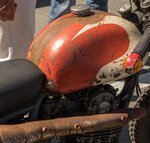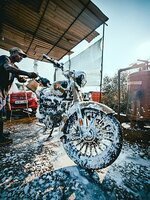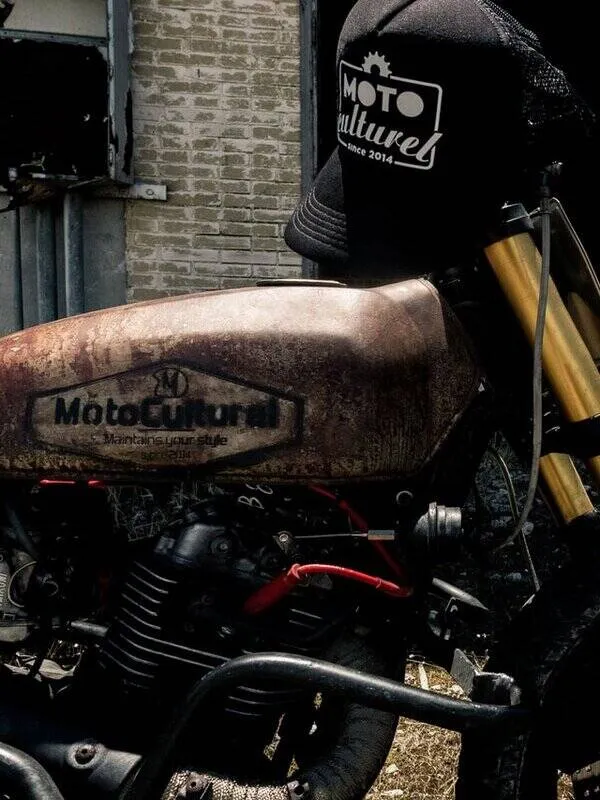Tired of replacing your fuel filters or cleaning those carbs, or looking to put your much-neglected bike back on the road? You will notice that your bike’s fuel tank will be in its most deteriorating condition due to flash rust. It’s not just about maintaining the looks of your fuel tank from the outside. Maintaining the inside of your fuel tank is even more critical. It tends to influence the overall performance of your bike in the long run. This guide will help you deal with how to prevent flash rust in a motorcycle gas tank without any external help.
How to Clean a Fuel Tank
Examine your fuel tank

Motorcycle tanks are different from one another. It means that they are going to deteriorate over time in various ways as well. You might see traces of rust on some of those tanks, while other bikes have their fuel vessels with even worse rust than the Queen Mary’s hull.
So, handling both these scenarios is going to be, more or less, the same. You can always look for a replacement for your old rusty tank. This is one of the most viable options because you need to find a tank that can work with your bike if it’s an old model. The replacement tank will work like a charm and make your old bike work like a new one again.
Of course, the replacement will not be that costly either, so it’s a pretty viable option for you to consider. Used tanks are a good option too. And if your bike is not that old, even your dealer might have a replacement tank on the shelf.
Some bikes have tanks that are built to last for a lifetime. For example, if you closely examine the old FatBob Harley-Davidson, its tank is thick steel and highly durable, and rust-resistant. Newer models have thinner gauge steel, so they are more prone to rust damage and are less stable. So, replacing them is a better option.
Paint rarity is another issue that you need to consider. If the hue is difficult to reproduce and match with other parts on the bike, it will cost much more. Hence, there are various factors to consider and then decide whether you should repair or remove the tank and get a new one instead.
How are you going to get rid of the rust?

Most of these tanks need 2-prong fork treatment. The first prong will deal with those heavy rust deposits, and the second one will freshen the surface finish. And this will become helpful for you to install the tank sealer.
You need to go for the mechanical treatment for the rust removal while the finish treatment is done chemically. But if you have experience handling rust previously, you can add your steps here in this process.
For the mechanical removal of the rust, you need to go for an abrasive element. It needs to be something that you can put in the tank to scale the rust off the tank’s inside surface. Bolts and nuts work great as an agitator. Some people also use gravel for this purpose.
For the chemical aspect of this treatment, you need to go for acid treatment. A mild acid like white vinegar is going to be a suitable starting point for you. And if required, you can go for a stronger option as well.
Prepare the tank

It’s time to prepare your tank for the treatment and remove the fuel from it. Just seal the holes that are there in your tank. Most of them will have filler caps along with an outlet for the petcock. Other tanks might also come with crossover tubes.
There are few options for you to try out here. For example, you can go with silicone plugs and vinyl or rubber vacuum caps for the bungs and small holes. If you have a new motorbike, you will see that you have to pull out the fuel pump plate.
These can be pretty tricky to seal as they are significant. You can go with a block-off plate and a gasket for fabrication. If you have decided to go with the vinegar, you can seal the filler with these caps. But replace the cap and the replacement seal once you are done replacing the seal.
Move to a ventilated area
You need to do this in a properly ventilated area because the acid is going to splash around. You don’t want anything to be around it. Even if you are using vinegar, you don’t want those acid fumes to build up inside your house.
It will give off a pretty objectionable odor, and doing this inside is a bad idea in every sense of the word. It would be better for you to have a catch basin underneath and then work on your tank. If you are working with something strong, you will move through the process quickly, so stressing on this part won’t be that much important in such a scenario.
Test the agitator
You need to check your agitator and see if it doesn’t react with the acid you are using for cleaning purposes. Test it out in a bowl or a glass and make sure that there are no reactions.
When you are using vinegar, you might not have to worry about any damage. The case will be more questionable if you are using a stronger acid. Still, you need to make sure that you check how the agitator works with the acid before you put everything in your tank.
Go for the acid and the agitator
It is highly recommended that you don’t go for anything more substantial than the white vinegar. Anything stronger will eat your tank up from the inside. You will also have to dispose of it very carefully, and an extreme dilution would be mandatory.
Your petcocks are going to disintegrate altogether if you are using something stronger. And the same thing is going to happen to the paint. You will also have to protect yourself from the acid too. So, it will be better for you to have a garden hose nearby.
But some tanks are extraordinarily rusty, and using white vinegar is not going to cut it at all. Therefore, you will have to go for something stronger. And in that scenario, you will have to be more careful as well. It is recommended that you should have a base to neutralize the acid.
When you are convinced that everything works and your agitator are a good combination with the acid you are using. Using the right-sized agitators is essential too. You need to go for smaller agitators because more giant bolts will dent your tank from the inside.
Shake, flush, and finish
Now pick the tank up and start shaking it. Continue doing that until you get tired. Now open the tank and see what’s the progress. You can begin to repeat the shaking if you think that some work is left to be done. But the purpose here is to start seeing the bare metal right through the filler cap.
You can keep this process going throughout the day if you want. But don’t leave your tank out in the open if it’s cold outside. When you flush your tank, have a bucket of hot water (not boiling) sitting around and flush the tank in that along with the agitator. Have a garden hose ready as well as you want all the acid out.
Now put some hot water in and add some dish soap into the tank for neutralizing the acid. Wash it thoroughly, and the tank will dry out from the inside because of the heat from the hot water. In the end, you need to use a tank sealer to finish the job.
Don’t go for a commercial tank sealer because they go wrong and are a waste of money. Tanks that need sealers need to be replaced. But different people might have different opinions, and that’s fine. That’s all in how to prevent flash rust in a motorcycle gas tank.
How Do You Keep a Motorcycle Gas Tank from Rusting?

Want to know how you can keep your motorcycle gas tank from rusting? Well, it’s not that difficult of a job to carry out. You will have to make sure that your tank is always filled with high octane gas, and you always use a fuel stabilizer, especially when you know your bike is not going to be used at all.
A better practice for preventing flash rust in a motorcycle gas tank is that you need to remove the tank entirely if your bike sits idle for long periods. Also, make sure you place your bike in an area not too exposed to the elements. And of course, don’t store your gas tank with its filler cap off where moist air can enter and react with the inside metal of the tank.
How To Prevent Flash Rust In A Motorcycle Gas Tank After Cleaning?

Do you need to protect your tank from rusting after cleaning? Yes, and you will have to do that each time you clean your tank. How to prevent flash rust in a motorcycle gas tank after cleaning is a thing too.
You can go for a gas tank sealer to prevent your gas tank from rusting once you are done cleaning. This sealer is highly viscous and moves like molasses. So, you will have to be extremely patient in applying a coat or two on the inside of your tank.
Don’t go for a thick sealant, or it will make things extremely difficult for you. You will have a hard time getting the sealer into those hard-to-reach areas. And there are chances that coats are not going to be even as well. Before you fix the tank back on your bike, you will have to make sure that it doesn’t contain any moisture at all.
FAQ
Will WD40 prevent flash rust?
Yes, you can always use WD40 to prevent flash rusting. But also make sure that you don’t leave your tank empty. Just have something inside it, either in the form of a treatment or a fuel.
How do you cure flash in rust?
You need to clean the water source and make sure that it doesn’t contain too many contaminants because they start the flash rusting process. You can always add a rust inhibitor when vapor abrasive blasting or wet blasting your tank.
Will vinegar remove rust from gas tanks?
Yes, vinegar is highly effective in getting the rust out of your tank as it has acetic acid in it. But make sure that you leave your tank overnight for the best results.
Conclusion:
Thinking about how to prevent flash rust in a motorcycle gas tank? It can be pretty tricky if you are not very careful in using the right kind of cleaner. You need to treat your tank both mechanically and chemically for the best results. Some people would prefer to go for a much stronger chemical treatment, but it’s not that safe.
But before you do anything, make sure that you thoroughly assess the overall conditions of your tank. If it needs replacement, that would be a better decision because you will do this cleaning process very soon in the future. This is because the tank is just beyond repair.

